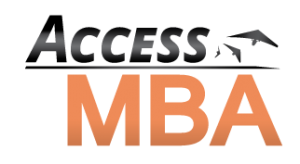 When choosing a business school, the more information and close contact that you have with the school before applying, the more intelligent your decision will be. The Access MBA Tour introduces MBA applicants to European and American MBA Admissions Directors in over 50 cities around the world. Candidates meet business school representatives in individual 20-minute long meetings, enabling them to determine if the programme is a good match for their expectations and career plans. In turn, Admissions Directors see the meetings as pre-Admissions interviews, or a starting point for the recruitment process.
When choosing a business school, the more information and close contact that you have with the school before applying, the more intelligent your decision will be. The Access MBA Tour introduces MBA applicants to European and American MBA Admissions Directors in over 50 cities around the world. Candidates meet business school representatives in individual 20-minute long meetings, enabling them to determine if the programme is a good match for their expectations and career plans. In turn, Admissions Directors see the meetings as pre-Admissions interviews, or a starting point for the recruitment process.
Because Access MBA’s events are held twice a year in select international destinations, not all MBA candidates have the chance to participate in person (see the Tour Schedule here). While the www.accessmba.com website is rich in school selection and admissions advice, most online MBA data and rankings point to the superiority of American programs. Here are some of the advantages European business schools have over their overseas counterparts.
Less Expensive
The two-year programme is still considered to be the American standard for the full-time MBA. In Europe the duration of the course is one year or eighteen months. The shorter programme duration is less expensive and entails lower overall living costs. Nevertheless the quality of the programmes is very high, which explains the growing number of triple accredited business schools in Europe.
More Specialised MBA Programmes
Europe boasts schools that are known for certain specific core competencies, such as ESSEC for luxury brand management, EM Lyon for Entrepreneurship, Grenoble GSB for Technology Management or St. Gallen University Business School for integrative management. Switzerland also has another unique management programme offering in the form of the International Organisations MBA offered by the University of Geneva (HEC). It prepares professionals for careers in the fields of international governmental and nongovernmental organisations and companies that work with these institutions.
More International
GMAC reports state that in the US 38% of participants are from foreign countries, while the percentage of international students in European MBA programmes is 83%. Due to this, the teaching language at most business schools in Europe is English. University alliances and exchange programmes contribute to highly diverse and international student bodies.
Better Return on Investment
The Financial Times value-for-money rankings show that European schools are doing better than their American counterparts. With all due critical attitudes towards such calculations and lists, the top 10 European and American schools would be as follows: The first 10 are made up of European institutions, then the 11th to 20th are American institutions. The question of the quality of business schools is open to debate, and can never be resolved satisfactorily. However, in terms of ROI, the European MBA seems to be gaining the upper hand.
More Experienced Professionals in Class
The age of students in European schools is generally higher than that of American schools. This may give experienced professionals who want to go back to university an argument in favour of the Old Continent. On the other hand, US institutions accept more people in their programmes.
Smaller Classes, More Individual Attention
The size and culture of a school are often overlooked when considering business schools. In general, schools in the US are larger, with an average intake of 287 full-time MBA students, compared with 124 in Europe. The professors may therefore devote only limited time for individual work with each student.
Better Career Mobility
Thanks to the Bologna accord on higher education, European degrees can are recognised in most countries within the Eurasian continent, giving unprecedented access to career opportunities worldwide. This also means that MBA graduates are not confined to working in the country they graduated from but can benefit from the common European job market.
Cultural Diversity
Cultural differences between European countries should not be underestimated when considering the added value of the programme. Historically built attitudes and social order fluctuate and create a secondary learning environment outside the classes.
Language Learning Options
It is a well known fact that a new language is learnt most efficiently by immersion. Even though English is the language of teaching in MBA programmes, outside the class students have the option to perfect their language skills with native speakers.
Meet Admissions Directors from European and American MBA programmes on a One-to-One basis on the Access MBA Tour. Register to be selected for business school meetings: https://www.accessmba.com/mba-events/access-mba-events/index.html?ui=VO5INN1390383428


I totally agree with you. Its absolute details about MBA. Check out http://www.mbaonemi.com/articles/a-z-about-mba/top-5-mba-specializations-in-india/